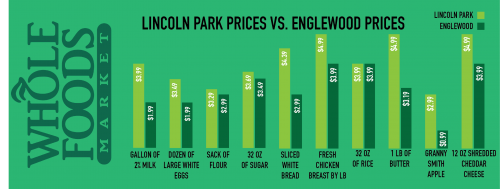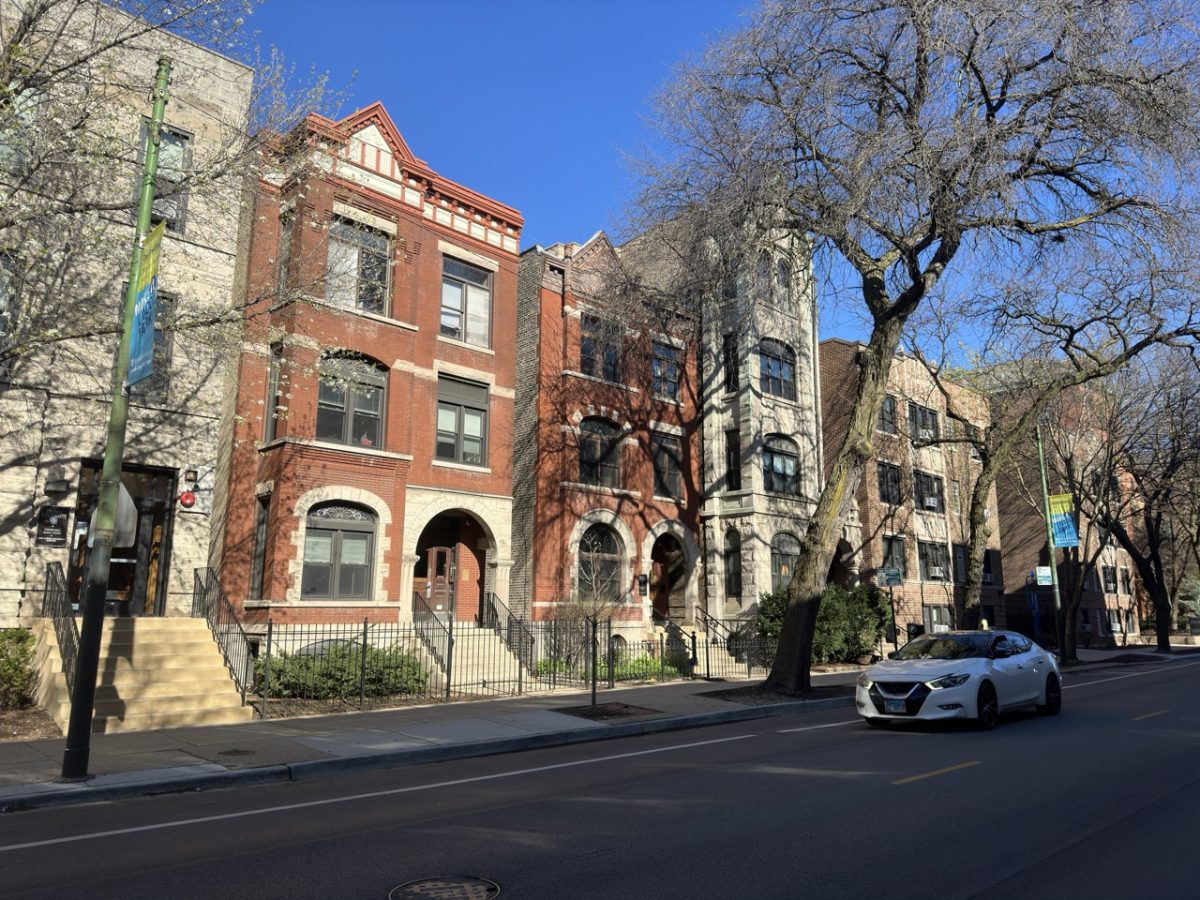When Vanessa Haslerig, an Auburn Gresham resident, heard of the city’s plan to build a Whole Foods in Englewood, her initial reaction was one of disbelief. Now, it has become a place that she loves to visit.
“I didn’t believe they were going to do it. When I saw what they did I was excited,” said Haslerig. “The people are great here. The produce is always fresh and beautiful. I love it. I get carried away coming here.”

Located on the Southwest Side of Chicago is Englewood, one of Chicago’s top five most violent neighborhoods. According to the 2010 census figures, Englewood population in 2010 was 30,654 residents, made up of 96 percent African-Americans.
The population has dropped dramatically since its peak of more than 90,000 in the the 1960s, when Englewood was known as home of the second busiest shopping district in Chicago at 63rd and Halsted.
Over several decades, as the neighborhood has seen a decline in business and population, many grocery stores closed or moved to new locations, leading to a such a lack of fresh food that Englewood became known as a food desert.
To help revitalize Englewood, the city proposed a plan to revitalize the once thriving area around 63rd and Halsted. That corner has now transformed into Englewood Square. Within this refurbished foundation is a brand new Whole Foods, Chipotle, and Starbucks.
Whole Foods finished construction in fall of last year, promising in a press release, to bring “good, affordable, healthy food” to the area.
Haslerig appreciates the market store for allowing her to maintain her vegetarian diet by offering organic products for an affordable price.
“The organics are a great price here. This is closer to home and they have most of the things I buy, fresh produce especially. I do a lot of juicing. I’m a vegetarian, so this is perfect for me,” said Haslerig.
There were many concerns with the new store. Is this store meant for Englewood residents? Would it employ residents from the area? Would it be affordable to the residents that needed access to fresh food?
Price Comparisons
The DePaulia examined prices of area grocery stores to see if the Whole Foods guarantee for fresh affordable food is still living up to that promise.
Looking at Jewel-Osco, Aldi, and Whole Foods across the Chicago area, the DePaulia put together a chart that summed up the price differences based on neighborhood and store.

The most striking difference in price comparison is the gap between Aldi prices and Whole Foods. At the Aldi store in Bolingbrook, you can get a loaf of white sliced bread for 80 cents, whereas a customer pays $2.99 at the Englewood Whole Foods.
Despite the high prices compared to other brand stores, the price differences between the Whole Foods in Lincoln Park and Englewood are stark. Englewood Whole Foods is sometimes one or two dollars more affordable than Lincoln Park.
Employment Status
One of the promises Whole Foods made to the city was to provide job opportunities for Englewood residents. According to the statistical analysis, 17.1 percent of Englewood residents are unemployed. 31.4 percent are employed and 51.3 percent are not in the labor force.
In contrast, Lincoln Park unemployment is only at 4.2 percent overall, with an additional 22.7 percent not in the labor force. With a large university and many affluent residents, Lincoln Park has advantages over a neighborhood like Englewood.
According to Chicago Now, Whole Foods provided an employment education series for the Englewood area. This allowed for many residents to learn the skills required to work at the store. Chicago Now reports that 85 of the 100 employees live on the South Side, including 35 residents of Englewood.
Whole Foods also promised to bring in vendors from the neighborhood to boost the economy.
Lamar Harvey, a supervisor at the Englewood store, said, “We have a ton of local vendors that are actually from the area that provide fresh produce as well. It’s a win-win situation. The community gets fresh produce; local vendors get the opportunity to display their products in a retail store. We have roughly about 20-25 vendors from the Chicagoland area.”
Household Income Versus Prices
The DePaulia discovered the prices are still expensive considering the median household income in Englewood.
According to Statistical Analysis, the median annual income per house is $18,900. In Lincoln Park, it is much higher at $88,700. That’s a difference of 78.7 percent in household income.
Although the prices are largely different from Lincoln Park, the Whole Foods in Englewood still charges a shopper $3.99 per pound for fresh chicken breast. That is only one dollar less than Lincoln Park, a 25 percent difference.
The Lincoln Park store also offers more options to their customers with a 29,600-square-foot store, almost twice the size of the 18,000-square-foot store in Englewood.
At a median household income of just $18,900, many residents do not have the liberty to choose between the fresh food offered by Whole Foods and the more affordable option, like Aldi or Jewel-Osco.
Englewood Mall TIF Funds
The Englewood Mall project’s purpose is to make Englewood a more desirable place to live. With 200 new job opportunities and workforce training programs, Englewood Square is giving hope to the residents as a positive environment.
Originally called the Englewood Mall Area TIF Redevelopment Plan and Project, the project’s plan is to bring growth back to the once lively shopping district.
TIF (Tax Incremental Financing) funds, which come from Cook County property taxes, have been allocated to Englewood Square since 1989. According to the City of Chicago website, TIF funds help “reverse disinvestment trends” and help provide “new institutional uses, mixed-income housing development and rehabilitation, and related initiatives.”
The biggest investment the city and Mayor Rahm Emanuel have made in the Englewood Mall project was bringing Whole Foods to the area. For 25 years, the city invested little into the Englewood Mall project.
In 2014, the city allocated nearly $11 million to the project, which is 73 percent of the total $14.4 million spent there between 1989 and 2017. The majority was spent on preparing the site and construction.
A large part of the plan was to bring Whole Foods to the Englewood Mall. According to Forbes, Whole Foods Market is worth $9.7 billion. Several residents wondered why Whole Foods did not pay for the construction instead of using city tax money.
The Whole Foods public relations office did not respond with a comment on the TIF money.
Michael Scott, a local shopper of the Englewood Whole Foods, said “TIF money is very corrupt, very scandalous. Social funding, community building improvement, education improvement, that’s what TIF money should be used (on).”
Located in a small block radius in the middle of the Englewood neighborhood is newly-minted Englewood Mall. The Whole Foods looks alien in the Englewood neighborhood. Across the street are weathered and stained buildings, some vacant.
Despite looking out of the ordinary, the revival of Englewood Square seems to be a welcome change by Whole Foods customers and employees. Many enjoy the lower prices and fresh, organic food. The new store has also started to bring opportunities to the community.
Whole Foods kept many of the original the promises: lower prices, fresh food, vendor opportunities, and hiring from the Englewood neighborhood.
This store seems to be on the right track to bringing change to a neighborhood that’s been disregarded by the city of Chicago for decades.







